The cryptocurrency market’s explosive growth has transformed it from a niche interest into a significant financial ecosystem worth trillions of dollars. Behind the price charts and trading interfaces lies a complex world of market microstructure—the intricate mechanisms that determine how assets are traded, how prices are formed, and how information flows through the system. Understanding this hidden architecture is crucial for traders, investors, researchers, and policymakers seeking to navigate the unique challenges and opportunities of digital asset markets.
This comprehensive analysis explores the fundamental components of cryptocurrency market microstructure, with a special focus on high-frequency trading (HFT) dynamics and order flow patterns. We’ll examine how these elements differ from traditional markets, analyze real-world examples of market events, and provide actionable insights for various stakeholders in the ecosystem. Whether you’re a sophisticated trader looking to refine your strategies or a policymaker considering regulatory approaches, this deep dive into crypto market microstructure will equip you with the knowledge to make more informed decisions.
Cryptocurrency Market Microstructure Fundamentals
Visualization of a cryptocurrency exchange order book showing bid-ask spread and market depth
Market Structure and Exchange Mechanisms
Cryptocurrency markets operate through a diverse ecosystem of exchanges, each with its own trading mechanisms, fee structures, and liquidity profiles. Unlike traditional financial markets with centralized exchanges and regulated trading hours, crypto markets function 24/7 across a global network of centralized exchanges (CEXs) and decentralized exchanges (DEXs). This fragmented landscape creates unique arbitrage opportunities but also presents challenges for price discovery and liquidity aggregation.
Most cryptocurrency exchanges employ a continuous double auction mechanism, where buy and sell orders are matched continuously rather than at discrete intervals. This mechanism allows for immediate execution when compatible orders exist, creating a dynamic environment where prices can change with each transaction. The matching engines that power these exchanges vary significantly in sophistication, with top-tier exchanges employing high-performance systems capable of processing thousands of orders per second, while smaller platforms may experience delays during high-volume periods.
Liquidity Dynamics in Cryptocurrency Markets
Liquidity—the ability to execute trades quickly with minimal price impact—is a critical aspect of market microstructure. In cryptocurrency markets, liquidity exhibits several distinctive characteristics:
Fragmented Liquidity Pools
Unlike traditional markets where liquidity tends to concentrate in a few major exchanges, cryptocurrency liquidity is distributed across dozens of significant trading venues. This fragmentation means that the “true” market depth for a cryptocurrency is the aggregate of liquidity across multiple exchanges, often requiring sophisticated routing systems to access efficiently.
Temporal Volatility
Cryptocurrency liquidity can fluctuate dramatically within short time frames. During market stress events, liquidity can evaporate rapidly as market makers pull their orders, leading to cascading price movements and flash crashes. This temporal volatility in liquidity is more pronounced in crypto markets than in traditional financial markets.
Asymmetric Depth
Order books in cryptocurrency markets frequently display asymmetric depth, with significantly more liquidity on one side than the other. This imbalance can signal market sentiment and potential price movements, making order book imbalance a key metric for traders and algorithms.
Stablecoin Influence
The presence of stablecoins as trading pairs significantly impacts liquidity dynamics. Major stablecoin pairs (like BTC/USDT) often have deeper liquidity than fiat pairs, creating complex flows as traders move between fiat, stablecoins, and cryptocurrencies.
Order Types and Their Impact
Cryptocurrency exchanges offer various order types that influence market microstructure in different ways:
| Order Type | Description | Market Impact | Common Usage |
| Market Orders | Execute immediately at the best available price | Take liquidity; can move prices with large orders | Urgent execution needs, regardless of exact price |
| Limit Orders | Execute only at specified price or better | Provide liquidity; build order book depth | Price-sensitive trading, market making |
| Stop Orders | Convert to market orders when price reaches trigger | Can create cascading effects during volatility | Risk management, trend following |
| Iceberg/Hidden Orders | Display only portion of total order size | Mask true liquidity; reduce market impact | Large traders seeking to minimize footprint |
| Time-Weighted Average Price (TWAP) | Algorithmic orders executed over time period | Distribute impact over time; create consistent flow | Institutional execution of large orders |
The mix of order types used in a market significantly influences its microstructure. Markets dominated by market orders tend to exhibit higher volatility and lower resting liquidity, while those with a higher proportion of limit orders typically display deeper order books and more stable price formation.
Master Cryptocurrency Market Microstructure
Download our comprehensive guide to understanding order book dynamics and liquidity patterns in cryptocurrency markets. Includes case studies and practical analysis techniques.
High-Frequency Trading in Cryptocurrency Markets
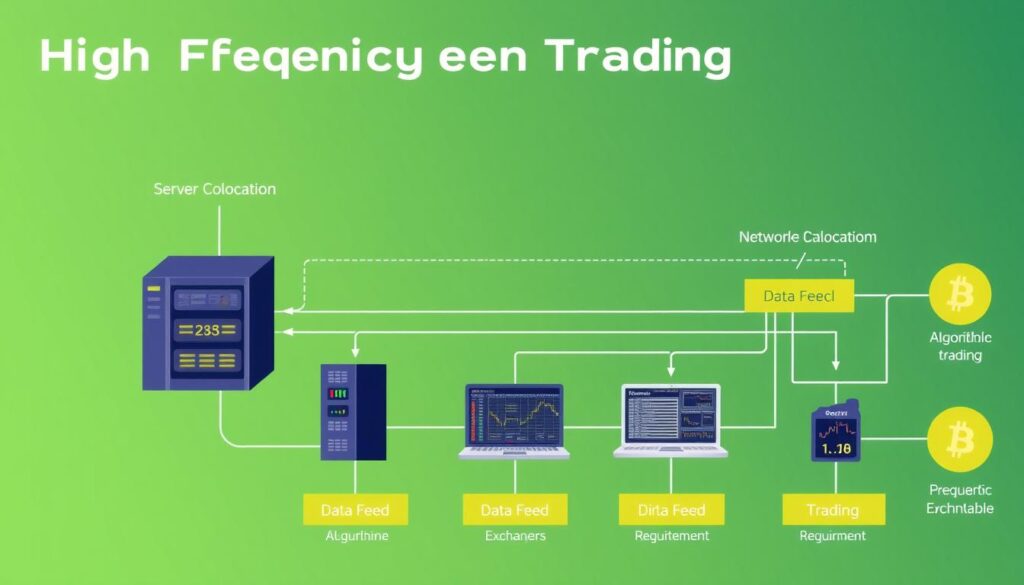
High-frequency trading infrastructure in cryptocurrency markets requires specialized hardware and connectivity
Evolution of HFT in Crypto Markets
High-frequency trading—characterized by ultra-fast execution, high order-to-trade ratios, and short holding periods—has evolved significantly in cryptocurrency markets. Initially limited by technical constraints and market inefficiencies, HFT in crypto has matured as exchanges have improved their infrastructure and institutional players have entered the space. Today, sophisticated HFT firms deploy similar strategies in crypto as they do in traditional markets, albeit with adaptations for the unique characteristics of digital assets.
The timeline of HFT adoption in cryptocurrency markets has been compressed compared to traditional markets. While HFT took decades to evolve in equities markets, crypto markets have seen rapid advancement in just a few years. This accelerated evolution has been driven by the transfer of expertise from traditional HFT firms, the open nature of cryptocurrency exchange APIs, and the significant arbitrage opportunities present in a fragmented market landscape.
Comparative Analysis: Crypto HFT vs. Traditional HFT
While high-frequency trading in cryptocurrency markets shares fundamental principles with traditional HFT, several key differences affect strategy implementation and effectiveness:
| Metric | Crypto HFT | Traditional HFT |
| Latency | 100-500ms | 5-20µs |
| Fees | 0.04-0.10% | 0.0001-0.002% |
| Market Hours | 24/7/365 | Exchange hours (typically 8-12 hours/day) |
| Market Fragmentation | High (100+ significant venues) | Moderate (10-20 major venues) |
| Colocation Availability | Limited (few exchanges offer) | Widespread (standard practice) |
| Regulatory Constraints | Minimal but increasing | Extensive (MiFID II, Reg NMS, etc.) |
| Cross-Asset Integration | Emerging (futures, options) | Mature (equities, futures, options, FX) |
Dominant HFT Strategies in Cryptocurrency Markets
Several HFT strategies have proven particularly effective in cryptocurrency markets:
Cross-Exchange Arbitrage
Exploiting price differences for the same asset across multiple exchanges. This strategy capitalizes on the fragmented nature of crypto markets, where the same asset can trade at different prices simultaneously. Success depends on fast execution and efficient capital movement between exchanges.
Market Making
Providing liquidity by simultaneously posting buy and sell orders with a small spread. Market makers earn the bid-ask spread while managing inventory risk. In crypto markets, market making often involves more sophisticated risk management due to higher volatility.
Statistical Arbitrage
Identifying and exploiting statistical relationships between related assets. This might involve trading correlated cryptocurrency pairs or exploiting temporary deviations from historical relationships. The strategy requires sophisticated statistical modeling and rapid execution.
Technical Infrastructure Requirements
Successful HFT in cryptocurrency markets requires specialized infrastructure:
Optimize Your Crypto Trading Algorithms
Access our HFT strategy backtesting tool to evaluate the performance of your trading algorithms against historical market data from major cryptocurrency exchanges.
Mapping Order Flow Patterns in Cryptocurrency Markets
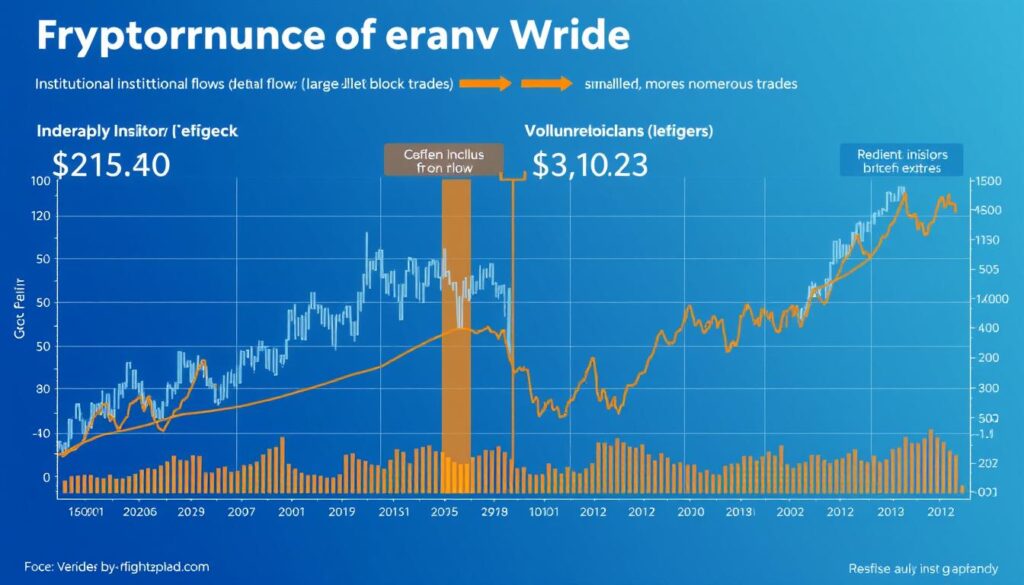
Visualization of order flow patterns distinguishing between institutional and retail activity
Understanding Order Flow Analysis
Order flow analysis examines the sequence and characteristics of orders entering the market to gain insights into trader behavior and potential price movements. In cryptocurrency markets, order flow analysis is particularly valuable due to the transparent nature of exchange data and the significant information content in order placement patterns. By analyzing who is buying and selling, at what prices, and in what quantities, traders can gain an edge in predicting short-term market movements.
The fundamental premise of order flow analysis is that order submission patterns contain predictive information about future price movements. For example, a large imbalance between buy and sell orders may indicate directional pressure, while changes in the composition of the order book can signal shifts in market sentiment. In cryptocurrency markets, where information asymmetry is often high, order flow analysis provides a window into the intentions of different market participants.
Identifying Market Participant Categories
Cryptocurrency order flow can be categorized by participant type, each with distinctive behavioral patterns:
Institutional Participants
- Large block trades (often >$100,000)
- Strategic execution to minimize market impact
- Use of algorithmic execution (TWAP/VWAP)
- Active during specific market hours
- Often utilize OTC services for largest trades
Retail Participants
- Smaller trade sizes ($100-$10,000)
- Higher proportion of market orders
- More responsive to short-term price movements
- Trading activity distributed across 24-hour cycle
- Higher sensitivity to news and social media
Whale Activity and Market Impact
Large holders of cryptocurrency, commonly known as “whales,” exert significant influence on market microstructure through their trading activities. These entities—which may include early investors, cryptocurrency foundations, mining operations, and institutional funds—can move markets through both their actual trading and the anticipation of their actions by other market participants.
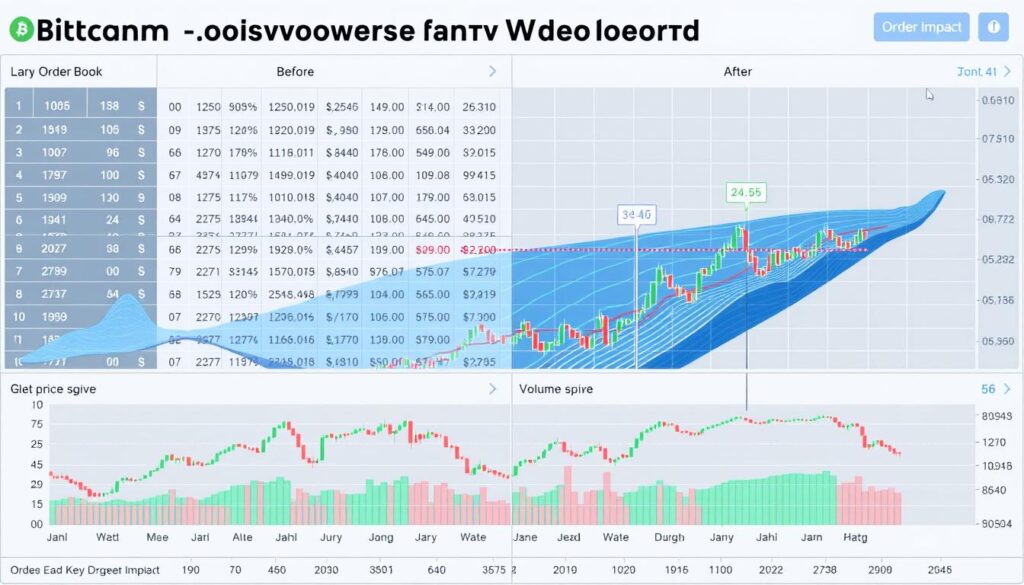
Market impact visualization of a large whale order on Bitcoin price and order book depth
Whale trading patterns typically exhibit several distinctive characteristics:
Bot-Driven Transaction Patterns
Automated trading bots account for a significant portion of cryptocurrency trading volume, with estimates suggesting they represent 70-80% of all trading activity on major exchanges. These bots employ various strategies that create distinctive order flow patterns:
Market Making Bots
These bots continuously post and update limit orders on both sides of the market, creating a distinctive pattern of frequent order placements and cancellations. They typically maintain a relatively balanced inventory position and generate high order-to-trade ratios. Market making bots are essential liquidity providers but can withdraw during high volatility, exacerbating price movements.
Arbitrage Bots
Arbitrage bots exploit price differences across exchanges or between related instruments. Their activity creates distinctive patterns of correlated trades across multiple venues, often with minimal delay between executions. These bots help maintain price consistency across the fragmented cryptocurrency ecosystem but can sometimes amplify flash crashes by rapidly withdrawing liquidity.
Momentum Bots
These algorithms identify and follow short-term price trends, creating self-reinforcing order flow patterns. They typically generate clusters of unidirectional market orders during price breakouts. Momentum bots can amplify price movements, creating cascading effects when multiple bots respond to the same signals.
Wash Trading Bots
Unfortunately, some exchanges employ bots that trade against themselves to artificially inflate volume statistics. These create distinctive patterns of matched orders with minimal price impact. Identifying and filtering out wash trading is crucial for accurate market analysis.
Retail vs. Institutional Flows
The balance between retail and institutional order flow significantly impacts market microstructure and price formation in cryptocurrency markets. Unlike traditional markets where institutional dominance is well-established, cryptocurrency markets feature a more dynamic interplay between these participant categories.
| Characteristic | Retail-Dominated Markets | Institutional-Dominated Markets |
| Volatility Profile | Higher short-term volatility | Lower volatility, more predictable patterns |
| Trading Hours | Activity distributed across 24 hours | Concentrated during business hours |
| Order Size Distribution | Predominantly small orders | Bimodal distribution (small and large) |
| Order Type Mix | Higher % of market orders | Higher % of limit and algorithmic orders |
| Price Impact | More reactive to news and sentiment | More driven by liquidity and flows |
The evolution of cryptocurrency markets has seen a gradual shift from retail to institutional dominance, particularly in major assets like Bitcoin and Ethereum. This transition has implications for market microstructure, including increased order book depth, reduced short-term volatility, and more sophisticated execution strategies. However, retail participation remains significantly higher than in traditional financial markets, creating a unique hybrid microstructure.
Decode Cryptocurrency Order Flow Patterns
Download our advanced guide to identifying and interpreting order flow signals in cryptocurrency markets, including techniques for distinguishing between different market participants.
Real-World Case Studies in Cryptocurrency Market Microstructure
Binance BTC/USDT Order Book Dynamics During Volatility
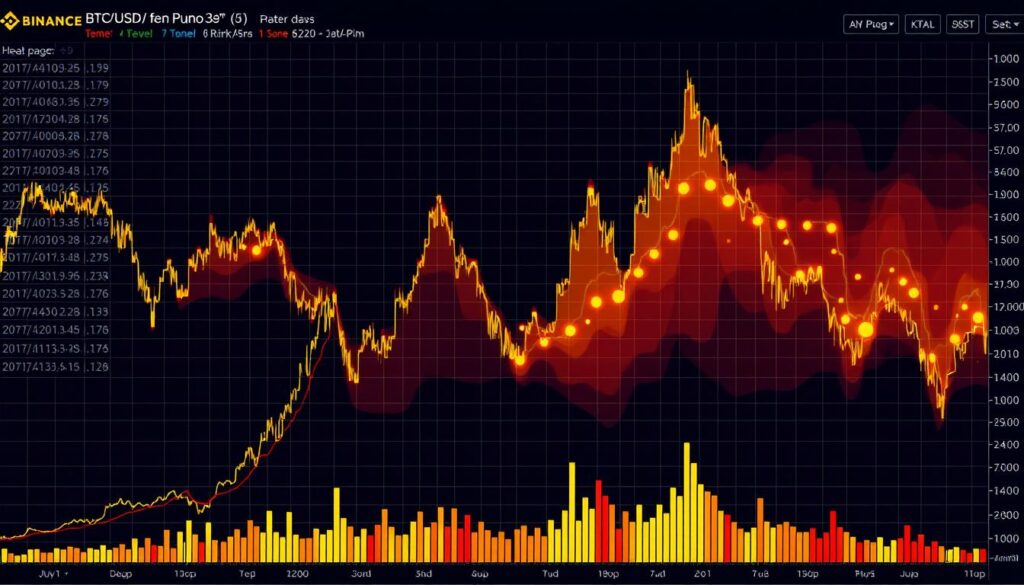
Heat map visualization of Binance BTC/USDT order book during extreme market volatility
On May 19, 2021, Bitcoin experienced one of its most significant single-day price drops, falling from approximately $43,000 to below $30,000 within hours. This case study examines the order book dynamics on Binance’s BTC/USDT pair, the most liquid cryptocurrency trading pair globally, during this extreme volatility event.
Pre-Crash Order Book State
Prior to the crash, the BTC/USDT order book displayed typical characteristics of a stable market:
- Relatively symmetric depth on both bid and ask sides
- Bid-ask spread averaging 0.01% (approximately $4-5)
- Visible support levels with significant limit order clusters
- Steady replenishment of consumed liquidity
During-Crash Microstructure Changes
As selling pressure intensified, several dramatic changes occurred in the order book:
- Asymmetric liquidity with bid side depth evaporating
- Bid-ask spread widening to over 0.5% at peak volatility
- Cascading liquidations creating large market sell orders
- Visible “gaps” in the order book where no bids existed
- Order book updates occurring faster than UI refreshes
Analysis of order flow during this event revealed that market makers rapidly withdrew liquidity as volatility increased, with order cancellation rates spiking to over 95%. This liquidity withdrawal created a self-reinforcing cycle where reduced depth led to greater price impact from market orders, triggering stop losses and liquidations, which in turn created more market orders hitting an increasingly thin order book.
The recovery phase showed a gradual return of market makers, first testing with small limit orders before committing significant liquidity. This case demonstrates how order book resilience—the ability to maintain depth during stress events—is a critical but often overlooked aspect of cryptocurrency market microstructure.
Ethereum Flash Crash Triggered by HFT Algorithms (2023)
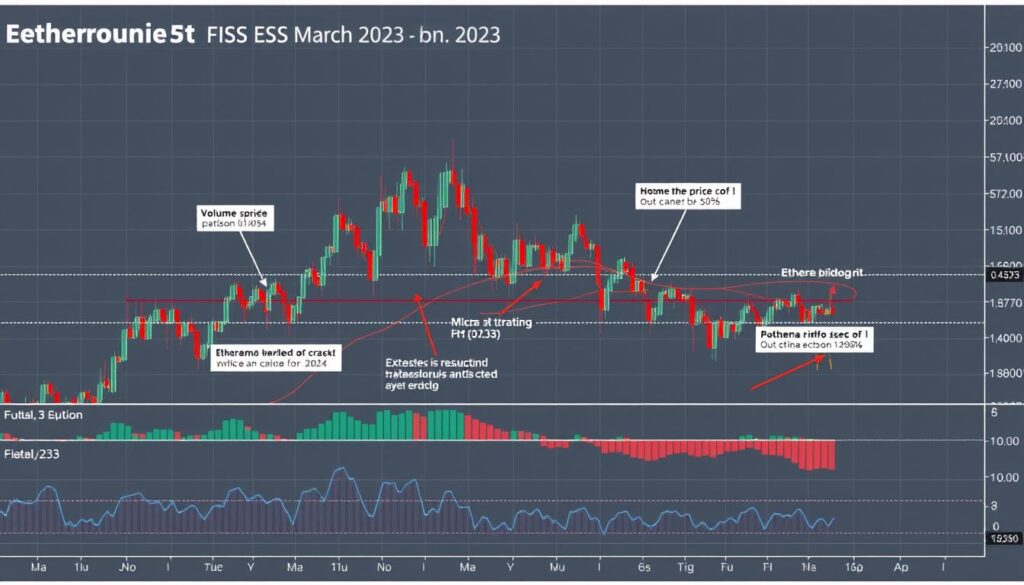
Ethereum price chart showing the March 2023 flash crash with algorithmic trading patterns highlighted
On March 3, 2023, Ethereum experienced a flash crash on several major exchanges, with prices briefly dropping over 20% before recovering within minutes. This event provides insights into how high-frequency trading algorithms can create and amplify market microstructure anomalies.
The crash sequence began with a large sell order on a derivatives exchange, which triggered a cascade of algorithmic responses:
Analysis of order flow data revealed that the entire crash and recovery occurred with minimal human intervention—algorithmic trading systems interacting with each other created both the crash and the subsequent recovery. This case highlights how the increasing dominance of algorithmic trading in cryptocurrency markets can create feedback loops that amplify initial price movements.
Tether Minting Events and Market Impact
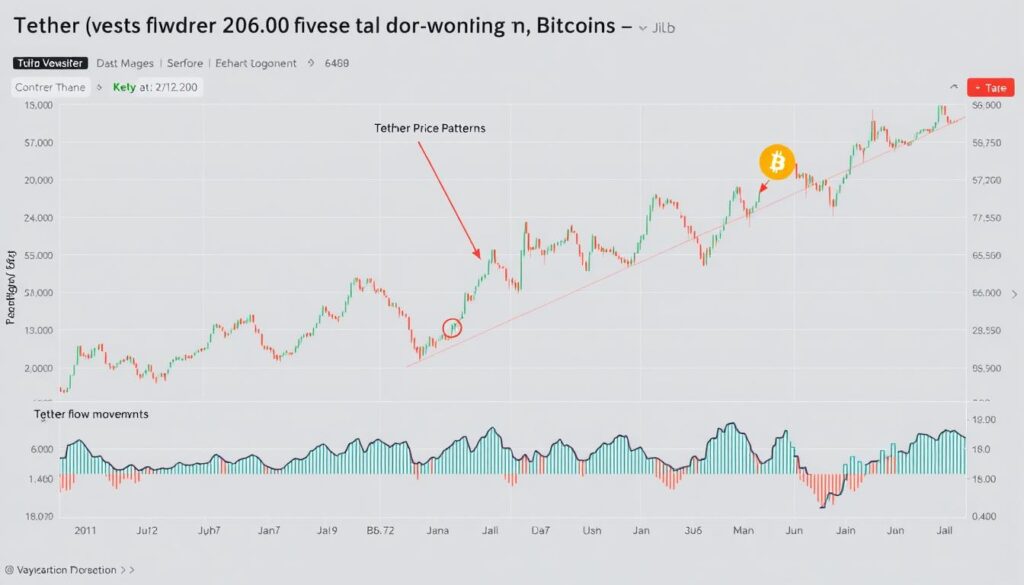
Correlation between Tether minting events and subsequent Bitcoin market activity
Tether (USDT), the largest stablecoin by market capitalization, plays a crucial role in cryptocurrency market microstructure. New issuance events—when Tether Treasury mints new USDT tokens—provide a unique window into how liquidity injections affect market dynamics and order flow patterns.
A study of major Tether minting events (>100 million USDT) between 2020-2023 revealed several consistent patterns in market microstructure:
Pre-Minting Phase
In the 24-48 hours before large minting events (which are visible on the blockchain before the tokens enter circulation), several anticipatory patterns emerged:
- Increased limit order placement at levels below market price
- Reduction in selling pressure across major exchanges
- Accumulation patterns from certain market participants
- Decreased liquidation rates despite price movements
Post-Minting Phase
After new USDT entered circulation, order flow analysis showed:
- Increased buy-side pressure, particularly in BTC and ETH markets
- Higher than average trade sizes (suggesting institutional activity)
- Stepped pattern of buying rather than continuous pressure
- Initial concentration on a few exchanges before spreading
- Reduced price impact per unit of volume (improved liquidity)
The data suggests that large Tether minting events create a distinctive order flow signature that reflects how new liquidity enters and circulates through the cryptocurrency ecosystem. This case study demonstrates how stablecoin dynamics have become an integral part of cryptocurrency market microstructure, creating unique patterns not seen in traditional financial markets.
Regulatory Challenges and Technological Innovations
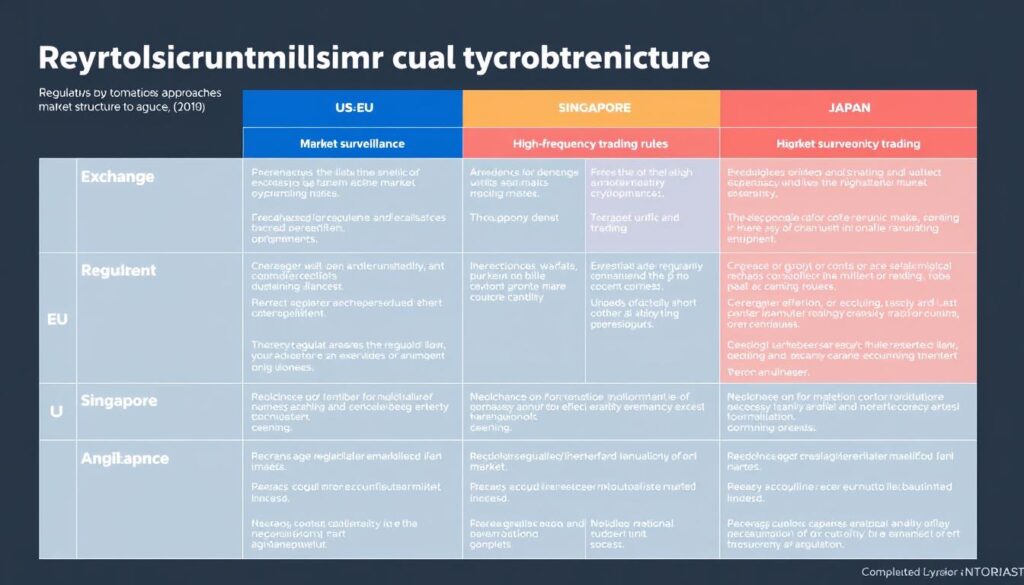
Comparison of regulatory frameworks for cryptocurrency market microstructure across jurisdictions
Regulatory Approaches to Crypto Market Microstructure
Regulatory frameworks for cryptocurrency market microstructure vary significantly across jurisdictions, creating a complex landscape for market participants. These approaches generally fall into three categories:
Comprehensive Regulation
Jurisdictions like Japan and Singapore have developed specific regulatory frameworks for cryptocurrency exchanges that address market microstructure elements including order types, trading mechanisms, and market surveillance requirements. These regimes typically require exchanges to implement specific controls against market manipulation and ensure fair and orderly markets.
Adapted Traditional Frameworks
The European Union (under MiFID II) and parts of the United States apply adapted versions of traditional securities market regulations to cryptocurrency trading. These approaches extend concepts like best execution, market abuse prohibitions, and transparency requirements to digital asset markets, though implementation details remain unclear in many cases.
Minimal Intervention
Some jurisdictions maintain minimal regulatory oversight of cryptocurrency market microstructure, focusing primarily on AML/KYC requirements rather than trading practices. This approach provides flexibility for innovation but can create challenges for market integrity and investor protection.
Key Regulatory Challenges
Several unique aspects of cryptocurrency markets create regulatory challenges:
Technological Innovations in Market Infrastructure
Despite regulatory challenges, significant technological innovations are reshaping cryptocurrency market microstructure:
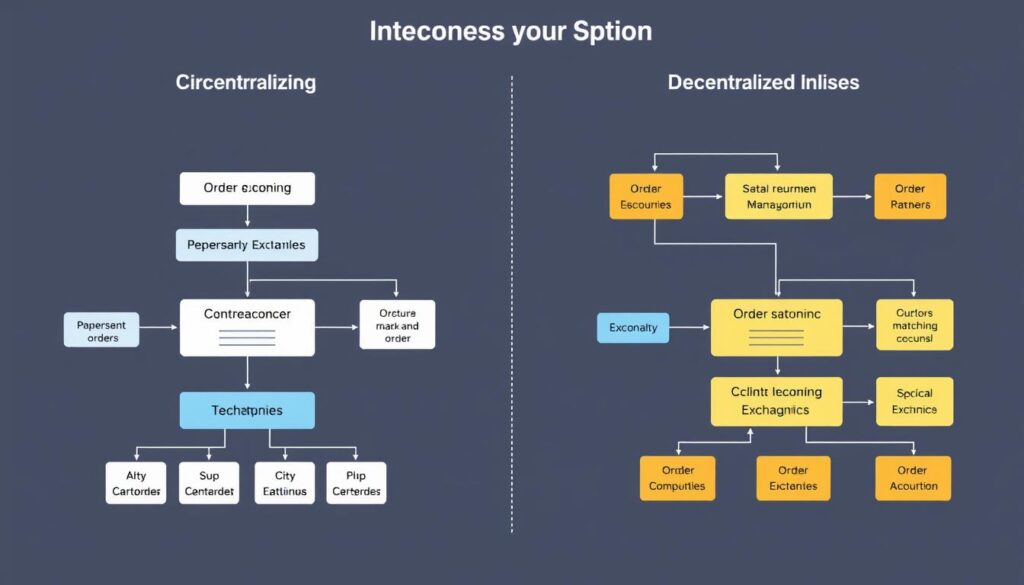
Architectural comparison of centralized and decentralized exchange order matching mechanisms
Automated Market Makers (AMMs)
AMMs have revolutionized decentralized exchange microstructure by replacing traditional order books with liquidity pools and mathematical pricing functions. This innovation enables continuous liquidity without traditional market makers but creates different microstructure dynamics, including impermanent loss, slippage-based pricing, and MEV (Maximal Extractable Value) opportunities.
Layer 2 Scaling Solutions
Layer 2 protocols like Optimistic Rollups and Zero-Knowledge Rollups are addressing the throughput limitations that have constrained DEX microstructure. By enabling higher transaction throughput and lower costs, these solutions are making DEXs more viable for high-frequency trading and sophisticated market making strategies.
Cross-Exchange Liquidity Aggregation
Technological solutions that aggregate liquidity across multiple exchanges are addressing the fragmentation of cryptocurrency markets. These systems route orders to venues offering the best execution, effectively creating a virtual consolidated order book that improves price discovery and reduces slippage.
Decentralized Oracle Networks
Oracle networks provide reliable price feeds to DeFi protocols, enabling more sophisticated derivatives and lending platforms. These systems are creating new forms of market linkage between on-chain and off-chain markets, with unique microstructure implications for arbitrage and price discovery.
DEX Limitations for High-Frequency Trading
While decentralized exchanges (DEXs) have grown significantly in volume and sophistication, they face several limitations that affect their suitability for high-frequency trading:
| Limitation | Impact on HFT | Potential Solutions |
| Block Time Constraints | Orders can only be executed at block intervals (e.g., ~12 seconds for Ethereum), making millisecond-level strategies impossible | Layer 2 solutions, specialized HFT-focused blockchains with sub-second finality |
| Transaction Costs | Gas fees make high-frequency, low-profit strategies economically unviable | Fee optimization, batch processing, layer 2 scaling solutions |
| Front-Running Vulnerability | Public mempools allow miners/validators to see pending transactions, enabling front-running | Flashbots, private order flow, time-weighted execution |
| Limited Order Types | Most DEXs support only basic order types, limiting sophisticated strategies | Off-chain order books with on-chain settlement, specialized DEX protocols |
| Deterministic Execution | Blockchain’s deterministic nature makes it difficult to gain speed advantages | MEV strategies, validator/miner relationships, priority gas auctions |
Despite these limitations, innovative approaches are emerging to enable more sophisticated trading on decentralized platforms. These include hybrid models that combine off-chain order matching with on-chain settlement, specialized Layer 1 blockchains designed for trading, and advanced MEV strategies that leverage the unique characteristics of blockchain-based markets.
Stay Compliant in Evolving Crypto Markets
Download our regulatory compliance checklist for cryptocurrency trading operations. Updated quarterly with the latest regulatory developments across major jurisdictions.
Actionable Insights for Market Participants
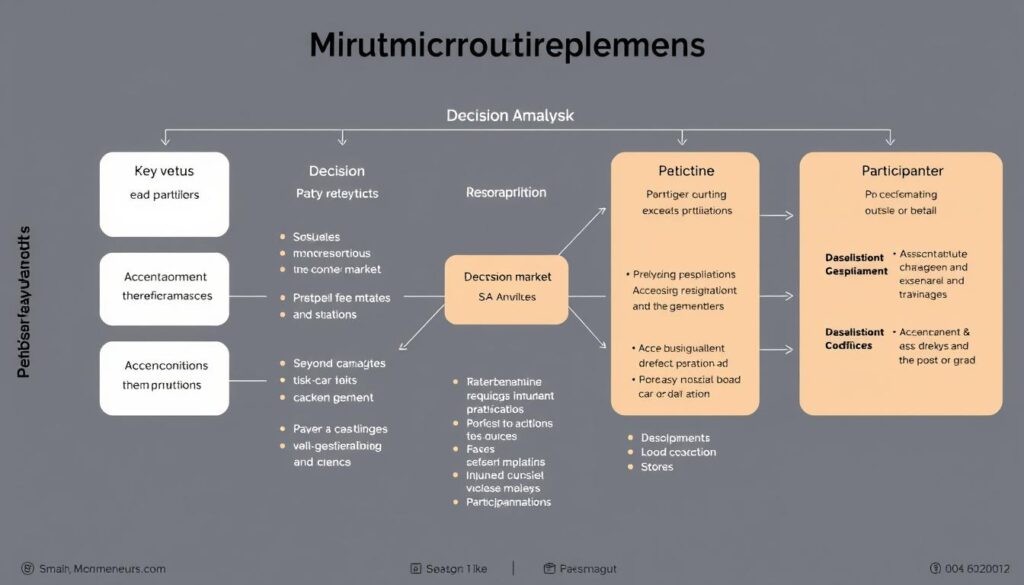
Decision framework for cryptocurrency market microstructure analysis showing key metrics and action points
For Traders and Investors
Understanding market microstructure provides several actionable advantages for cryptocurrency traders and investors:
Order Execution Optimization
Tailor your order execution strategy to market conditions by monitoring order book depth and liquidity distribution. During periods of thin liquidity, consider breaking large orders into smaller pieces or using time-sliced algorithms. When order book imbalances appear, adjust limit order placement to account for likely price movements.
Volatility Prediction
Use order book metrics as leading indicators of potential volatility. Watch for sudden reductions in order book depth, increasing cancellation rates, or growing bid-ask spreads as warning signs of impending volatility. During these periods, consider reducing position sizes or widening stop-loss parameters to avoid being caught in short-term liquidity cascades.
Exchange Selection
Evaluate exchanges based on microstructure quality metrics like order book resilience, market impact costs, and execution consistency. For large trades, prioritize venues with deeper liquidity and more sophisticated order types. For automated strategies, select exchanges with reliable API performance and consistent order book behavior.
Key Metrics to Monitor
Implementation Strategies
For Policymakers and Regulators
Effective regulation of cryptocurrency markets requires nuanced understanding of their unique microstructure characteristics:
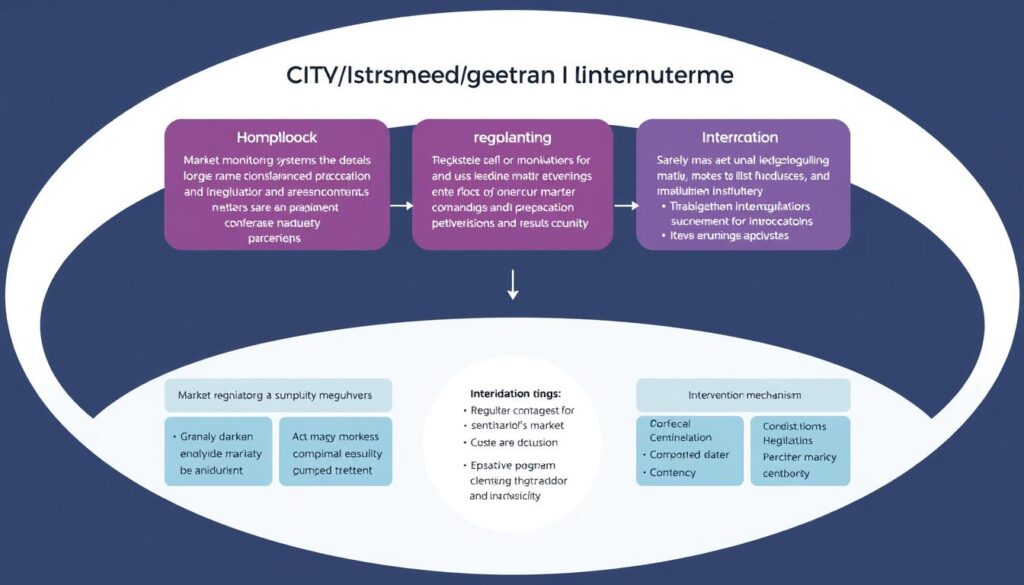
Regulatory framework for effective cryptocurrency market surveillance and oversight
Market Integrity Considerations
Innovation-Friendly Approaches
Balancing investor protection with innovation remains the central challenge for cryptocurrency market regulation. By focusing on market integrity and transparency while allowing for technological evolution, regulators can create frameworks that promote fair and efficient markets without stifling the unique benefits of cryptocurrency trading systems.
Master Market Microstructure Analysis
Download our comprehensive toolkit for cryptocurrency market microstructure analysis, including data collection scripts, visualization tools, and analytical frameworks.
Future Trends in Cryptocurrency Market Microstructure

Emerging trends in cryptocurrency market microstructure including AI integration and cross-chain liquidity
Technological Advancements
Several technological developments are poised to reshape cryptocurrency market microstructure in the coming years:
Quantum-Resistant Ledgers
As quantum computing advances, cryptocurrency protocols are implementing quantum-resistant cryptographic algorithms to protect transaction integrity. These changes will affect transaction validation times and potentially influence high-frequency trading dynamics by altering the fundamental speed limits of blockchain networks.
AI-Driven Order Routing
Machine learning systems are increasingly being deployed to optimize order routing across fragmented cryptocurrency markets. These systems analyze historical execution quality across venues and dynamically adjust routing decisions based on real-time market conditions, potentially improving liquidity utilization and reducing market impact.
Cross-Chain Interoperability
Advances in cross-chain bridges and interoperability protocols are creating more unified liquidity across previously isolated blockchain ecosystems. This development is likely to reduce fragmentation and create more efficient price discovery mechanisms across the broader cryptocurrency market.
Market Structure Evolution
The organizational structure of cryptocurrency markets is evolving in response to institutional demands and regulatory pressures:
Institutional Infrastructure
The development of institutional-grade trading infrastructure—including prime brokerage services, custody solutions, and clearing mechanisms—is changing market microstructure by enabling larger participants to trade more efficiently across multiple venues. This evolution is likely to increase overall market depth while potentially concentrating liquidity among fewer, larger players.
Exchange Consolidation
The cryptocurrency exchange landscape is likely to consolidate as regulatory compliance costs increase and economies of scale become more important. This consolidation may reduce fragmentation but could also concentrate market power, potentially affecting fee structures and market access for different participant types.
Decentralized Finance Integration
The growing integration between centralized exchanges and DeFi protocols is creating hybrid market structures with unique microstructure characteristics. These hybrid systems may combine the speed and efficiency of centralized matching engines with the transparency and settlement assurance of blockchain-based systems.
Regulatory Standardization
As regulatory frameworks mature, we’re likely to see greater standardization of market microstructure requirements across jurisdictions. This standardization may include common approaches to trade reporting, market surveillance, and order type restrictions, potentially reducing regulatory arbitrage opportunities.
Emerging Research Directions
Academic and industry research is exploring several promising directions in cryptocurrency market microstructure:
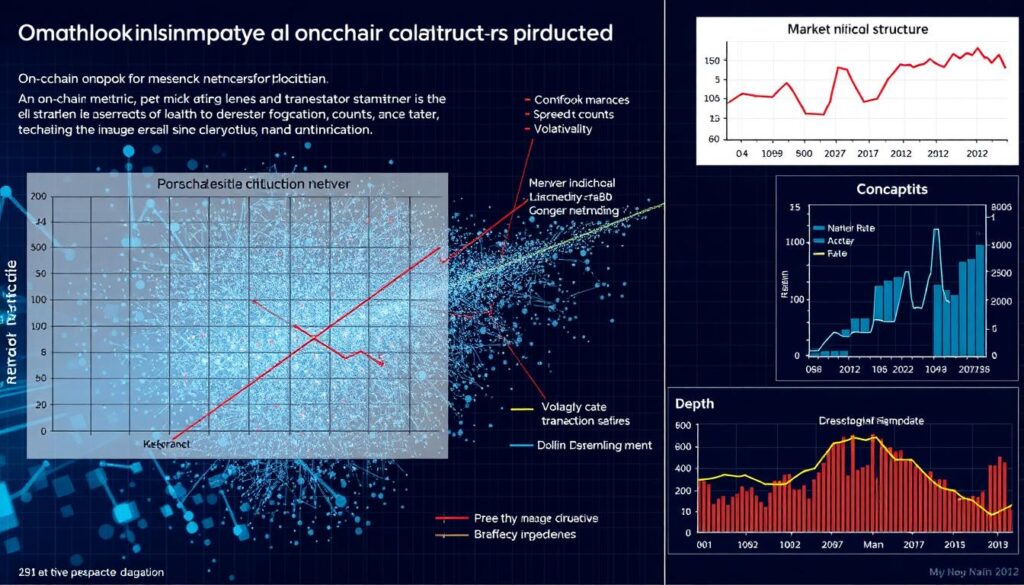
Research visualization showing correlations between on-chain metrics and market microstructure indicators
The future of cryptocurrency market microstructure will likely be characterized by increasing sophistication, greater institutional participation, and novel hybrid structures that combine elements of traditional and decentralized finance. Market participants who understand and adapt to these evolving dynamics will be best positioned to navigate the opportunities and challenges of this rapidly changing landscape.
Conclusion
Cryptocurrency market microstructure analysis provides a powerful lens for understanding the complex dynamics that drive digital asset markets. By examining the intricate mechanisms of order flow, market participant behavior, and exchange infrastructure, we gain insights that go far beyond what price charts alone can reveal. The unique characteristics of cryptocurrency markets—including 24/7 operation, global accessibility, and the interplay between on-chain and off-chain activity—create distinctive microstructure patterns that require specialized analytical approaches.
High-frequency trading in cryptocurrency markets continues to evolve, adapting strategies from traditional markets while developing novel approaches suited to the unique characteristics of digital assets. Despite higher latency and fees compared to traditional HFT environments, the significant arbitrage opportunities and market inefficiencies in cryptocurrency markets create compelling opportunities for sophisticated algorithmic traders.
Order flow analysis reveals the complex interplay between different market participants—from retail traders to institutional investors, market makers to algorithmic systems. By mapping these patterns and understanding their implications, traders can make more informed decisions about execution strategies, timing, and venue selection.
As cryptocurrency markets mature, the regulatory landscape and technological infrastructure continue to evolve rapidly. These changes will shape market microstructure in profound ways, potentially reducing some inefficiencies while creating new opportunities for innovative trading approaches. Market participants who stay informed about these developments and adapt their strategies accordingly will be best positioned to succeed in this dynamic environment.
Whether you’re a trader seeking to optimize execution, an investor trying to understand market dynamics, or a policymaker considering regulatory approaches, a deep understanding of cryptocurrency market microstructure is increasingly essential. By combining rigorous analysis with practical insights, this field offers valuable tools for navigating the complex and rapidly evolving world of digital asset markets.
Elevate Your Cryptocurrency Trading Strategy
Subscribe to our advanced market microstructure research service for regular insights, analysis, and trading strategy recommendations based on order flow and market structure patterns.

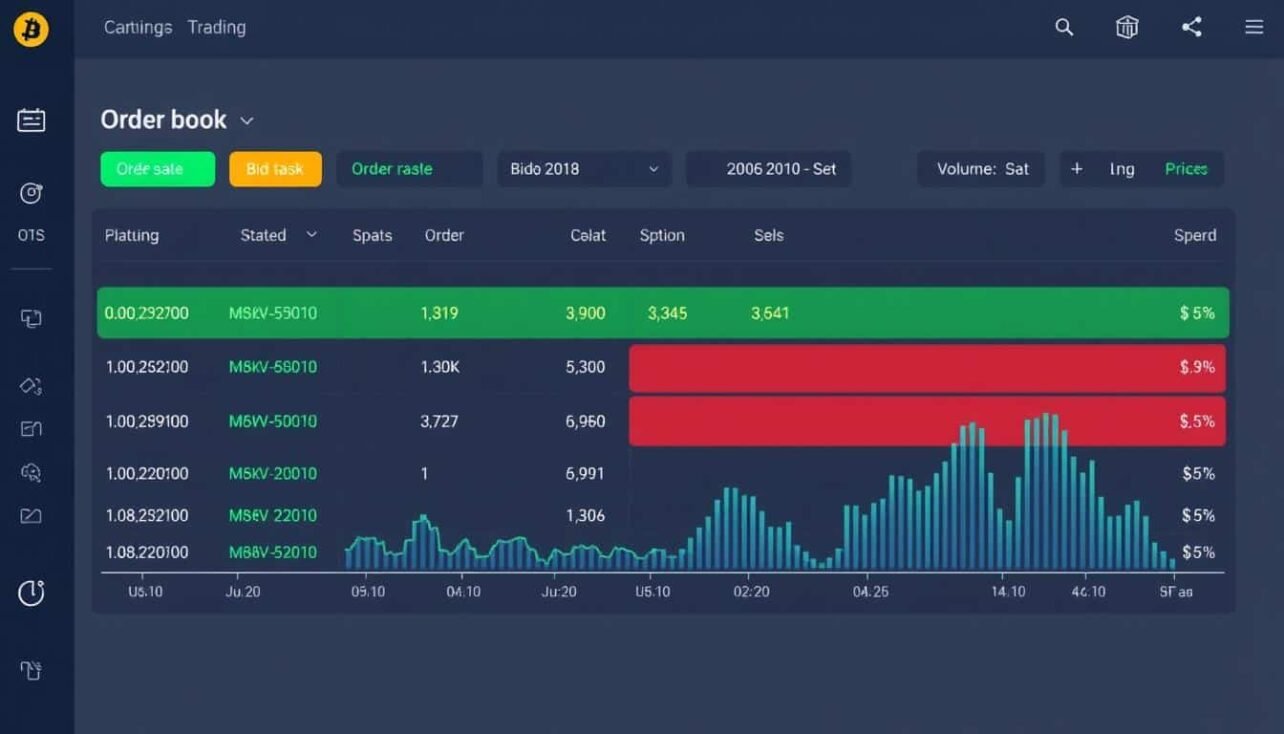
No comments yet